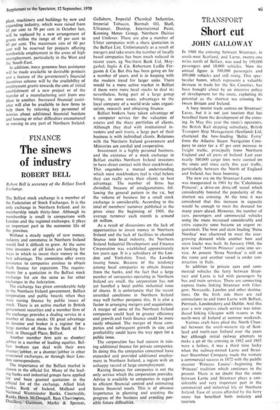TRANSPORT
Short cut
JOHN GALLOWAY
In 1960 the crossing between Stranraer, in south-west Scotland, and Lame, twenty-one miles north of Belfast, was used by 190,000 passengers and 18,000 vehicles. Now the annual figure is 500,000 passengers and 100,000 vehicles and still rising. This spec- tacular boom, which represents a valuable increase in trade for the Six Counties, has been brought about by an intensive policy of development for the route, exploiting its potential as the shortest sea crossing be- tween Britain and Ireland.
A busy tourist trade centres on Stranraer/ Lame, but it is not just tourism that has benefited from the development of the cross- ing. In May this year the route's operators, the British Rail shipping subsidiary, British Transport Ship Management (Scotland) Ltd, chartered the bow-loading 'Baltic Ferry' from the Atlantic Steam Navigation Com- pany to cater for a 47 per cent increase in freight traffic, principally from Northern England and all parts of Ireland. Last year nearly 500,000 cargo tons were carried on the route and since early this year traffic, particularly between the North of England and Ireland, has been booming.
The new era on the Stranraer-Larne route was inaugurated in 1961 by the 'Caledonian Princess', a drive-on drive-off vessel which considerably boosted the popularity of the shortest sea crossing. At the time it was considered that this increase in capacity would be enough to meet the demand for many years ahead. However, the number of cars, passengers and commercial vehicles using the route increased considerably and extra capacity soon became an urgent re- quirement. The bow and stern loading 'Stena Nordica' was chartered to meet the ever- growing demand while another bow and stern loader was built. In January 1968, the new vessel 'Antrim Princess' came into ser- vice. At present 'Stena Nordica' is still on the route and another vessel is under con- struction in Italy.
In addition to private cars and com- mercial vehicles the ferry between Stran- raer and Larne is fed with passengers by bus and train services. There are connecting express trains linking Stranraer with Glas- gow, Newcastle, London and other destina- tions. On the Irish side there are rail connections to and from Larne with Belfast, Portrush, Londonderry and Dublin. And this year a new express coach service was intro- duced linking Glasgow with resorts in the north-west of Ireland at summer weekends.
Various craft have plied the North Chan- nel between the south-western tip of Scot- land and north-east Ireland over the years but although initial railway attempts to make a go of the crossing in 1862 and 1865 were a failure, it was a third time lucky when the railway-owned Larne and Stran- raer Steamboat Company made the venture a commercial success in 1872 with the paddle steamer 'Princess Louise'—beginning the 'Princess' tradition which continues to the present. There is no doubt that the route between Larne and Stranraer plays a con- siderable and very important part in the commercial and industrial life of Northern Ireland. Ease of access afforded by the ferry route has benefited both industry and tourism.














































 Previous page
Previous page